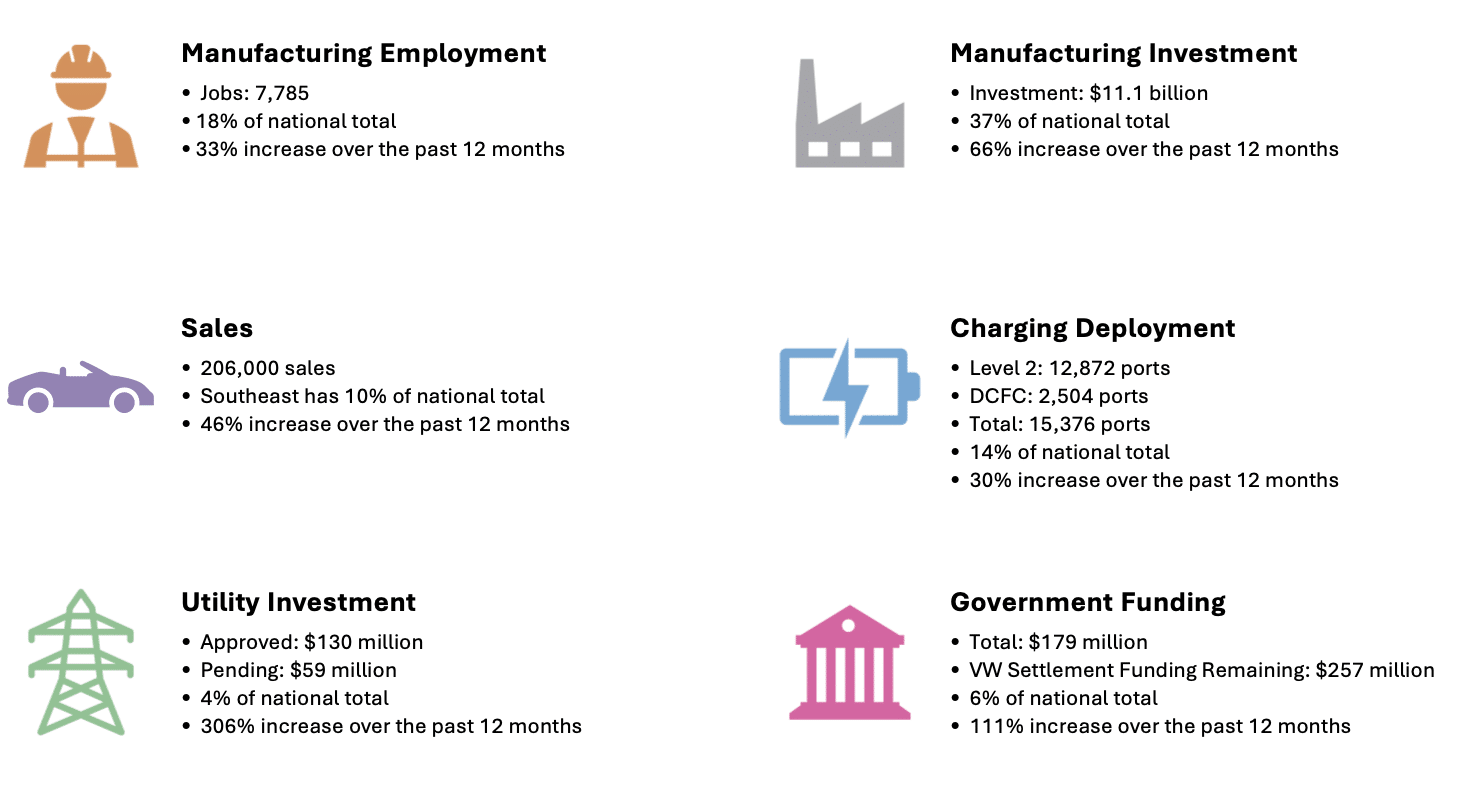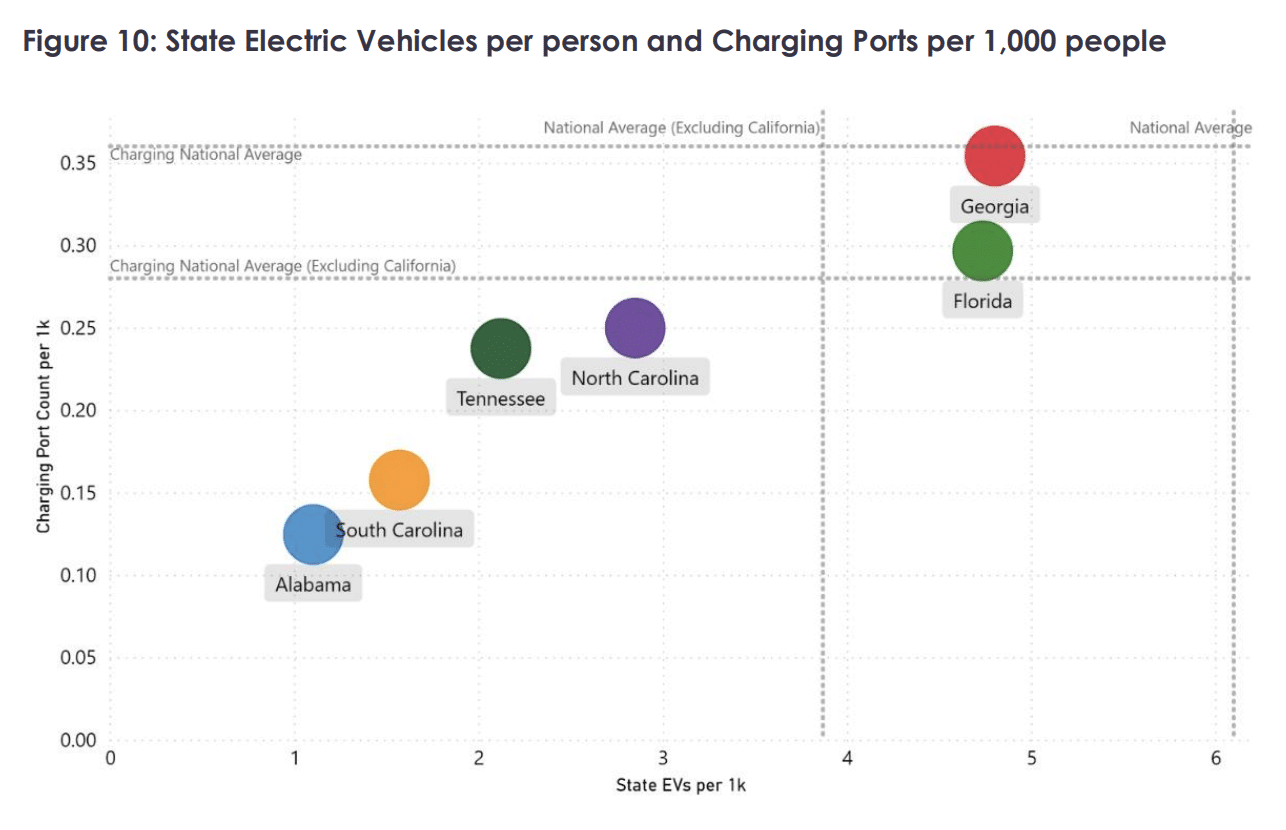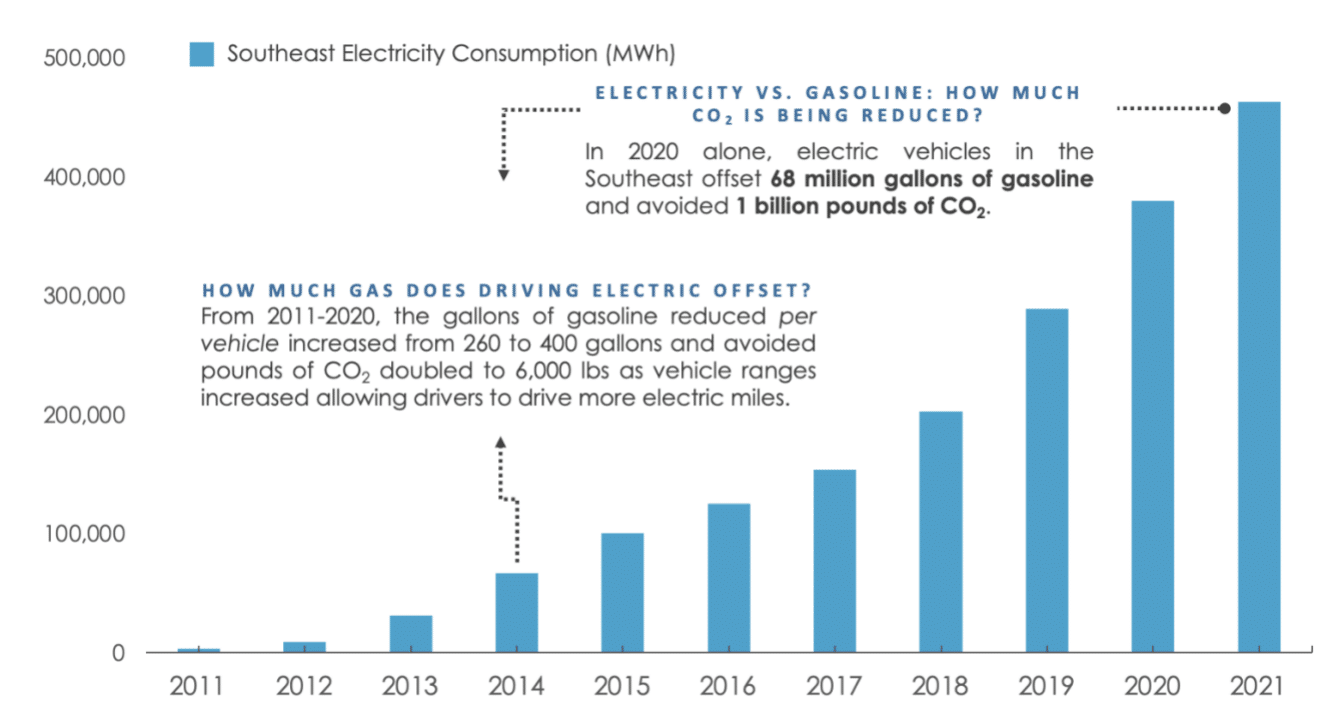Accelerated growth. That’s what happened across the electric vehicle (EV) market this year.
Consumers purchased EVs at a record pace. June and July recorded the highest number of monthly EV sales to date, and in September, 5.6% of all light-duty vehicle sales were EVs–the highest market penetration ever. Auto manufacturers committed over $60 billion in U.S. EV manufacturing expansion. Meanwhile, six leading automakers, including Ford and GM, thirty countries, and California, New York, and Washington pledged to phase out internal combustion vehicle production by 2040. And to help the transition, Congress passed the bipartisan infrastructure package that includes $7.5 billion to grow the nation’s EV charging station network from 100,000 to 500,000 stations.
Highlights from the Southeast
As reported in the “Transportation Electrification in the Southeast” report, this national momentum is mirrored across the Southeast, where EV manufacturing investment, job growth, EV sales, charging station deployment, electric utility investment, and government spending are all on the rise.
Southeast EV Market Indicators Through July 2021

Economic Development Expands
The Southeast, which historically lagged leading transportation electrification regions in EV sales and charging infrastructure deployment, further established itself as an EV manufacturing powerhouse. Regional EV manufacturing investments skyrocketed 66% from July 2020 to July 2021 to $11.1 billion. Since then, an additional $11.9 billion in investments have been announced that combined expect to add 15,200 EV and battery manufacturing jobs:
- Ford in Tennessee
- Toyota and Arrival in North Carolina, and
- Rivian in Georgia.
Currently, Tennessee is #1 in the Southeast in EV manufacturing investment and jobs. As of July 2021, the state had captured 25% of the nation’s EV manufacturing investment, up 172% from July 2020, and 9% of the related jobs, up 57%. And that’s before Ford announced a $5.6 billion vehicle and battery plant east of Memphis. With the year-end announcement that EV manufacturer Rivian will invest $5 billion in a new vehicle and battery manufacturing facility outside Atlanta, #2 for EV manufacturing investment and jobs, Georgia, is poised to give Tennessee a run for their money in 2022.
Automakers and supply chain companies are expanding in the Southeast because the region has an established automotive ecosystem, utility prices are low, states are providing attractive incentives, labor is cheaper and unions are weaker. The latter has become a flashpoint as the Biden Administration pushes for American-made and union-made EVs and batteries.
Utility Investment Booms
Investor-owned utilities (IOU) across the region ramped up investment in EV charging station deployment, rate designs to support car, truck, and bus electrification, and funding for electric school bus pilots. From July 2020-July 2021, regulator-approved IOU investments increased 306% to $130 million. And then approved rate case settlements with Duke Energy Florida and Florida Power & Light injected another $264 million, bringing the total to date to $394 million.
Florida is #1 in the Southeast for utility investment, with $337 million approved by the state’s utility commission. For perspective, North Carolina trails at #2 with $24 million approved and another $56 million awaiting regulators’ ruling. The ongoing challenge for utilities and regulators is to ensure that these and future investments enable equitable access for all to EV ownership and the resulting public health benefits and economic savings.
Utility investment is increasing because of two factors:
- Utilities are proposing larger more robust electric transportation pilot programs and
- Regulators are approving more of the rate-based programs.
As these pilot programs roll out, regulators, utilities, and advocates are going to be looking for results that demonstrate significant value to the nascent EV market and to rate-payers. Successful programs will provide widespread access to EV charging, increase EV sales, and generate new revenue for utilities that will put downward pressure on utility rates for all.
EV Sales and Charging Station Deployment Accelerates
From July 2020-2021, passenger EV sales in the Southeast were up 46%. Charging station deployment increased 57%. But in both categories, the region continues to lag, representing approximately 18% of the nation’s population but only 10% of EV sales and 14% of charger deployments.
Florida ranks on top regarding gross EV sales and infrastructure deployment. But when state population is accounted for, Georgia is #1 in both categories. Only Georgia and Florida perform within the national average ranges for percapita EV sales and chargers, while Alabama, North Carolina, South Carolina, and Tennessee continue to lag.

EV sales are going up as more consumers and fleet operators become aware of the technology’s benefits and as a wider range of EV models come to market. Automakers expect passenger EVs to reach price parity with gas cars in the next few years. When that happens, passenger EV sales are expected to skyrocket.
EV charging infrastructure deployment has been driven by state government funding through the Volkswagen Settlement and regional utility program investments. New federal infrastructure funding will further accelerate EV charger deployment over the coming years.
The Climate Imperative
On the heels of COP 26 this year, governments across the globe reaffirmed their shared belief that the climate crisis is upon us and measures to reduce carbon emissions must be increased worldwide. Transportation is the leading carbon polluting sector in the U.S. and in the Southeast.
Electric utilities are ramping up decarbonization efforts, making the electricity that EVs use cleaner every day. As the trend towards lower-carbon intensive electricity generation continues, transportation electrification’s climate benefits increase exponentially.
Southeast EV Electricity Consumption

What to Expect in 2022
The bipartisan Infrastructure Investment and Jobs Act will begin funding $5 billion in charging infrastructure that will be administered by state Departments of Transportation and soliciting proposals for the $2.5 billion in competitive grants. This $7.5 billion in EV infrastructure is more than invested to date by the nation’s states and utilities combined.
It’s a game-changer. The focus will now be on the state level, ensuring that the money is spent efficiently and effectively and that the result is greater and more equitable access to EV charging along highway corridors and across the country’s rural landscapes. Success will support consumers and fleet operators transitioning to electric cars, trucks, and buses.
Supposing a version of the Build Back Better Act can make its way through Congress, the approved infrastructure investments may be enhanced by financial incentives to help consumers and fleet operators purchase EVs that will remain more expensive than gas and diesel vehicles for a few years.
Combine this influx of funding with automakers’ 2022 plans to release dozens of new EV models, including the hotly anticipated Rivian R1T and Ford F150 Lightning pick-up trucks, and we have the makings for an exciting EV year. Stay tuned.
Electrify the South is a Southern Alliance for Clean Energy program that leverages research, advocacy, and outreach to promote renewable energy and accelerate the equitable transition to electric transportation throughout the Southeast. Visit ElectrifytheSouth.org to learn more and connect with us.



